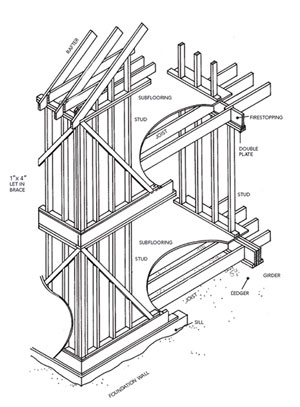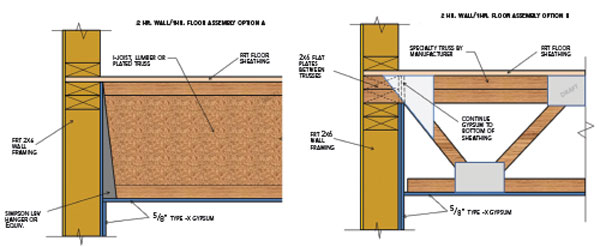Mass Timber and Wood Framing
Traditional Wood-Frame Construction
For centuries in North America, the dominant method of building homes and low-rise apartments has been wood frame construction, which has shown strength, longevity, and stability. Mid-rise light wood-frame structures are widely considered to be cost effective, due to relatively low material costs, reduced construction time, availability of resources and labor.4 The development of prefabricated component systems increases the strength and affordability of wood frame construction. Also, when built according to building codes and industry standards, wood-frame structures can provide hurricane and seismic resistance.
 |
Platform framing uses shorter lengths of lumber for the studs, generally 2x4s spaced 16 inches on center. Image courtesy of American Wood Council |
Wood-frame construction entails the use of wood-framing members, typically dimensional lumber, I-joists, or prefabricated wood trusses, spaced relatively close, and used with sheathing or decking to create a structure that can withstand loads. Modern wood framing essentially includes three types: balloon, platform and semi-balloon framing.
Balloon Framing
With long lumber lengths, vertical load-bearing framing studs run continuously from foundation to roof. Intermediate horizontal floor joists are nailed to the sides of the vertical studs and bear on a ledger. The ledger is notched into the stud. Typically this system is more common in two-story buildings due to the stud length availability. However, a variation of this method could be used in increments of two stories. The advantage to this is that it would eliminate the shrinkage that may occur from the floor joists.
Platform Framing
Over time, platform framing replaced balloon framing as the dominant framing method. Platform framing uses shorter lengths of lumber for the studs, generally 2x4s spaced 16 inches on center. The walls are typically framed with a sill or sole plate, studs and two top plates, then floor joists bear on the top plates. Platform framing does not require hangers, while semi-balloon framing does as described below.
At each story, joists are covered by subflooring providing a platform, or work surface, on which walls and partitions are easily erected. The benefits of platform framing include the fact that walls can be constructed on the ground and less effort is involved in lifting them into place than in balloon framing. Notching of the stud is not required, and after one story is constructed, the framers can utilize it to construct the next story. Platform framing also accommodates various prefabricated methods.
Semi-Balloon Framing
Semi-balloon framing is a cross between balloon framing and platform framing. Where balloon framing has a continuous stud from foundation to roof, semi-balloon framing does not. Balloon framing does not require hangers, whereas semi-balloon framing does.
While platform framing is more dominant overall, modern semi-balloon framing, in which the floor joist hangs from the double top plates, is more common in buildings that are five stories and up, and is ideally suited to certain circumstances. According to Michelle Kam-Biron, P.E., S.E., senior technical director, lead for mid-rise construction for WoodWorks, “In the U.S., where most states follow the International Building Code, semi-balloon framing is often used as an alternative to platform framing in structures where fire requirements or shrinkage may be a challenge.” Type III construction requires non-combustible exterior walls but there is an exception in the code that allows for fire-retardant treated wood (FRTW). “Designers will sometimes utilize semi-balloon construction, hanging the joist off the top plates and eliminating the penetration of the exterior wall building envelope,” Kam-Biron says.
 |
(Left) Semi-balloon framing is more common in buildings five stories and higher; (Right) it is often used as an alternative to platform framing where fire requirements or shrinkage may be a challenge. Photo courtesy of US WoodWorks |









